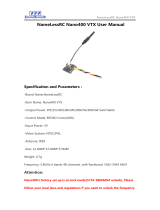
UNDER THE HOOD OF THE SOUNDSTATION VTX 1000
Polycom, Inc. Page 2 of 6
Preface
Since its introduction a short time ago, interest in the Polycom SoundStation VTX 1000
has been intense. In many respects, it is a revolutionary product. It is the first integrated
audioconferencing system to provide wideband audio capabilities over the public
telephone network; this alone makes it a major advance over the existing state of the
industry. But there are numerous other firsts in the SoundStation VTX 1000. Some of
these will be helpful to those who are using, selling, or considering a purchase of the
system, and some may just be interesting to know. The purpose of this paper is to give a
peek inside the SoundStation VTX 1000, to help you understand just why this system is so
extraordinary.
Capabilities and Characteristics
Some of the capabilities of the SoundStation VTX 1000 relate directly to its current
features, while others may be more fully utilized in the future (yes, its software is
upgradeable; more about that later), or in specific installations. Here are some of its
internal characteristics and capabilities.
Digital Architecture. The SoundStation VTX 1000 operates on the TriMedia processor
core, running at 200 MHz. This is a multiprocessing DSP that runs five execution units
simultaneously, producing an aggregate of over 1000 million operations per second
(MOPS), and more than 800 million floating point operations per second (MFLOPS). In
calculation capacity, this can be compared to a one-GHz Pentium IV. Program and
ringtone storage is 4 MB, operating memory is 16 MB. This is over 100 times the
processing power of the SoundStation, one thousand times the available memory.
Software Architecture. The SoundStation VTX 1000 contains six independent 14kHz
audio processing input channels: one for each of the three internal mics, two external
mics, and the auxiliary input channel. Each of these performs a complex set of algorithms
in both time and frequency domains, at some points operating on internal representations
of the audio signals which are broken into 320 separate frequency sub-bands. By
comparison, the SoundStation Premier has three input channels, each processing eight
sub-bands.
Tone Controls:
Two tone controls, one treble and one bass, can be accessed through the
keyboard. Each of these is implemented as a double biquad IIR digital filter, acting on the
audio path that leads to the loudspeaker.
PSTN Interface.
The telephone interface resides in the Palomod (a name combined from
the Unimod of SoundStation and SoundStation Premier, and the name that the project
team gave the SoundStation VTX 1000 while we were developing it, Palomino). This is a
special circuit with extremely low distortion that is configured and controlled (no more
DIP switches for worldwide flexibility) by a local microprocessor. It is also controllable to
present a wide range of real and complex impedances to the attached telephone line,







